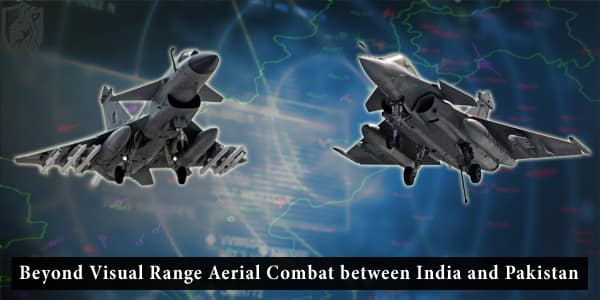
World Largest BVR Battle
The extensive aerial confrontation between the Pakistani Air Force (PAF) and the Indian Air Force (IAF) last month, sometimes referred to as the “largest Beyond Visual Range (BVR) engagement in history,” has rapidly transformed into a case study for air forces around the world.
Thailand has recently shown significant interest in the extraordinary BVR incident, with the Royal Thai Air Force apparently arranging a conference to analyze the Pakistan-India aerial stalemate.
Images disseminated on social media depict the Royal Thai Air Force conducting a conference entitled “Analysis of the India-Pakistan Air Conflict, May 7–8, 2025,” which distinctly categorizes the event as “the largest BVR air combat in history.”
Senior Pakistani authorities, as reported by the prominent US network CNN, described the confrontation between the PAF and IAF pilots as “the largest air battle in history,” including an unprecedented 125 combat aircraft from both nuclear-capable adversaries.
CNN adds that, although both forces remained within their designated airspace, they engaged in missile exchanges at ranges of up to 160 km, deploying modern air-to-air missiles and heavily utilizing their AESA radars for targeting and tracking.
75–80 IAF jets
Pakistan’s Foreign Minister, Ishaq Dar, affirmed that PAF fighters engaged with around 75–80 IAF jets in what he characterized as the most extensive BVR confrontation ever documented.
“Dar asserted that we successfully intercepted five of those Indian fighter jets.”

Islamabad strategically responded to India’s Rafale purchase by introducing the J-10C. It aimed to restore some aerial balance in South Asia’s tense skies. Equipped with advanced radar and electronic warfare systems, the J-10C can fire long-range missiles like the PL-15.
Pakistan ordered 25 J-10Cs in December 2021. The first batch arrived for Pakistan Day celebrations on 23 March 2022. Since then, Pakistan has acquired more and is negotiating for up to 60 aircraft.
This expansion seeks to strengthen air defenses against India’s growing Rafale fleet. US aerospace analyst Michael Dahm highlighted the key lesson from the India-Pakistan BVR clash. Pakistan demonstrated its ability to integrate Chinese fighters, sensors, and command systems into an effective “kill chain.”
Dahm, cited by Air & Space Forces Magazine, stressed that controlling the kill chain is more important than individual aircraft performance. The kill chain covers target identification, engagement, and battle damage assessment in a seamless process.
China Space News report
Dahm explained that Pakistan linked ground-based radar with fighters and AEW&C aircraft. He described an operation that was detailed in a China Space News report dated 12 May. Pakistan’s Air Force executed an operation where ‘A’ initiated, ‘B’ executed, and ‘C’ directed the mission.
In modern warfare, speed, real-time intelligence, and accuracy make the kill chain vital. The kill chain has six stages: Identify, Replace, Track, Target, Engage, and Assess. These stages rely on ISR drones, high-speed data links, satellite communications, and increasingly autonomous weapons.

Dahm described a likely scenario where Pakistan’s ground radar detected incoming Indian fighter aircraft. This radar was possibly integrated with Pakistan’s air defense network. A PAF J-10C then launched a BVR missile from a standoff range.
An AEW&C aircraft used a mid-course data link to guide the missile towards its target. Dahm said, “It was a long-range, beyond-visual-range shot, most likely using the export variant PL-15E.” The PL-15, developed by China’s CAMA, is among the most capable BVR missiles in the world.
US military’s CJADC2 framework
It competes with top Western designs such as the AIM-120D and Meteor. Pakistan’s kill chain integration method resembles the US military’s CJADC2 framework. CJADC2 aims to link operations across all services and domains.
Dahm noted that fuller details of the engagement could clarify Pakistan’s integration level compared to India’s. He added that Pakistan is believed to have modified several Chinese AEW&C aircraft for electronic warfare roles. The use of these EW capabilities to influence the electromagnetic battlespace remains unclear.
When comparing Chinese and Western technology, Dahm suggested that the differences may not be significant. Moreover, he stressed that system connectivity, crew training, and tactics often matter more than hardware specifications. As a result, these factors can ultimately outweigh simple comparisons of one fighter type against another.
Conclusion
Although India’s Air Force is qualitatively superior, Dahm emphasizes its broad and varied inventory. This mix of Western, Israeli, Russian, and indigenous technologies creates significant hurdles for cohesive kill chain integration.
Furthermore, the IAF operates a diverse fighter fleet, with platforms from multiple origins. These include French Rafales, Russian Su-30MKIs and MiG-29s, Dassault Mirage 2000s, domestically produced Tejas jets, and older SEPECAT Jaguars from the UK.
Because of this variety, India enjoys the advantage of flexibility, supporting a wide range of missions and fostering a highly skilled workforce.
However, this same diversity also introduces substantial integration challenges across different systems.
For instance, avionics and electronic warfare tools must, therefore, work together seamlessly to ensure operational efficiency.
In addition, data protocols and communication networks require constant synchronization. These must also align closely with ground radars and AWACS platforms. Consequently, India faces persistent pressure to maintain smooth interconnectivity during operations.
While the benefits of such variety are clear, managing this complexity demands exceptional coordination and sustained effort.
Ultimately, in the age of data-driven warfare, the real test will be how effectively India can merge these disparate systems into a unified and resilient kill chain—an ability that could decide aerial supremacy.
References
- CNN – Pakistan-India Air Conflict
🔗 cnn.com - Air & Space Forces Magazine
🔗 airandspaceforces.com - China Space News (12 May Report)
🔗 spacechina.com - Mitchell Institute for Aerospace Studies
🔗 mitchellaerospacepower.org - Royal Thai Air Force – Official Facebook
🔗 facebook.com/royalthaiairforce - Defence News Today
🔗 defensenewstoday.info - Pakistan Defence Forum – Facebook Group
🔗 facebook.com/groups/pakistandefenseforum






